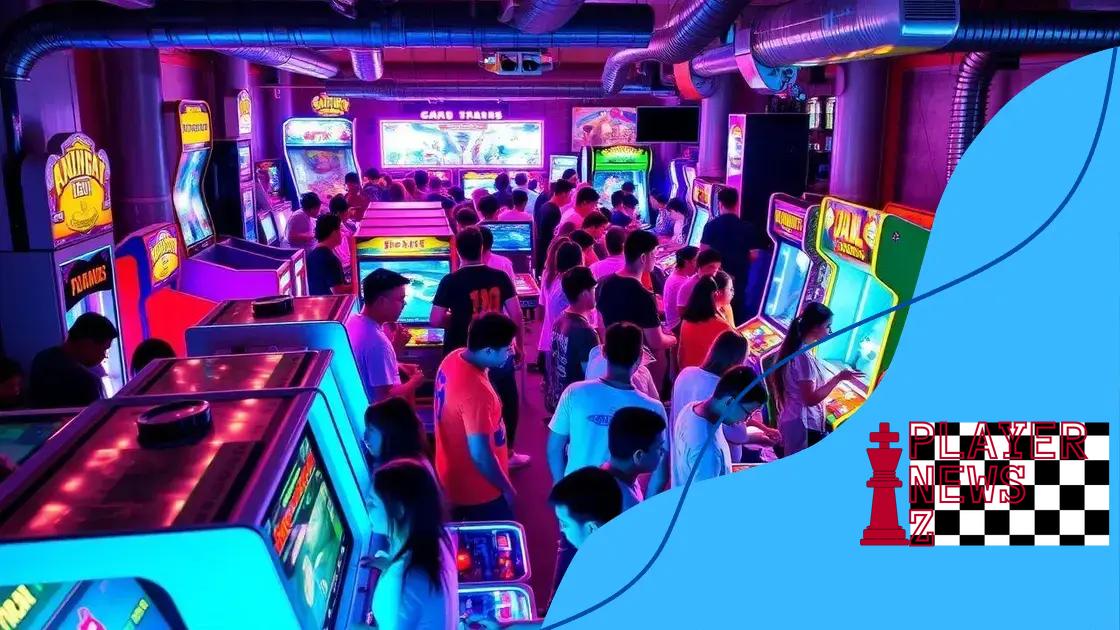The cultural impact of 1980s arcade games

The cultural impact of 1980s arcade games laid the groundwork for modern gaming by introducing essential mechanics, fostering community, and establishing iconic characters that continue to influence game development today.
The cultural impact of 1980s arcade games can still be felt in today’s entertainment landscape. From their vibrant graphics to competitive gameplay, these games not only entertained but also brought people together, fostering friendships and communities. Ready to dive into this nostalgic world?
The rise of arcade culture
The rise of arcade culture in the 1980s transformed how people interacted with video games. These brightly lit rooms were not just about playing games; they became social hubs where friends gathered to compete and connect. The atmosphere buzzed with excitement, laughter, and the sounds of gaming.
Popularity of arcade games
Various games captivated the public’s attention and contributed to the surge in arcade culture. Titles like Pac-Man, Donkey Kong, and Space Invaders drew players in with engaging gameplay and colorful graphics.
- Pac-Man became a cultural icon, with its unique maze and ghost-chasing gameplay.
- Donkey Kong introduced players to new challenges and advanced narratives in gaming.
- Space Invaders sparked fierce competition with its intense, fast-paced action.
As these games gained popularity, arcades began popping up in malls, restaurants, and dedicated gaming centers. Young people flocked to these locations, hoping to rack up high scores and show off their skills. The arcade experience was not just about gaming; it was a place to socialize and build friendships.
The social aspect of arcade gaming
Arcades facilitated social interaction in ways that home gaming consoles could not. Players found common ground, challenged each other, and shared tips to improve their gameplay. Tournaments often turned a casual outing into a highly competitive event.
This sense of community was vital for the arcade culture’s growth. Players would form groups, often waiting in line for hours to get a chance to play the latest games. The excitement of watching someone achieve a high score became a shared experience, fostering bonds among gamers.
The rise of arcade culture also impacted the broader entertainment industry. As players began to demand more sophisticated gaming experiences, developers responded by creating more advanced games. This led to an evolution in both arcade machines and home consoles, eventually shaping the games we enjoy today.
Ultimately, the rise of arcade culture in the 1980s laid the foundation for the modern gaming landscape. The social connections forged in these vibrant spaces continue to influence how we perceive games today. Many enduring friendships and happy memories stemmed from those arcade visits, showcasing the lasting impact of this unforgettable era.
Iconic games that defined a generation
Iconic games that defined a generation in the 1980s shaped the gaming landscape we know today. These games captured the hearts and minds of millions, creating lasting memories and setting new trends. They introduced players to innovative gameplay and unforgettable characters, making gaming an essential part of pop culture.
Pac-Man
Pac-Man revolutionized how games were played, combining strategy with fast-paced action. Players maneuvered their yellow hero through mazes while avoiding ghosts, all while eating pellets and fruit. This game became a cultural phenomenon, inspiring merchandise and even an animated series.
Donkey Kong
Donkey Kong marked a significant shift in the gaming narrative. Players took control of Mario as he climbed platforms to save a damsel in distress from the giant ape. This game not only introduced Mario but also set the stage for character-driven games in the future.
Space Invaders
Space Invaders brought players together in a new type of competition. It was one of the first arcade games to feature an increasing difficulty level. Gamers formed lines at arcades, eager to compete for high scores and beat their friends. The simple yet addictive gameplay captivated audiences worldwide.
Galaga
Galaga enhanced the space shooter format by introducing new mechanics, such as the ability to capture enemy ships. This game pushed players’ skills to the limit, fostering camaraderie and competition in a crowded arcade. Its vibrant colors and engaging gameplay made it a favorite.
These titles weren’t just games; they were social experiences that bonded friends and sparked rivalries. The innovation found in these iconic games allowed the gaming industry to flourish and inspired countless developers. The legacy of these pioneers continues to influence modern gaming, proving that their impact is far from over. As we look back, we recognize that these games played a vital role in bringing gaming into the mainstream and shaping a generation’s entertainment choices.
Social dynamics in arcade gaming

Social dynamics in arcade gaming were crucial to the popularity of arcade culture in the 1980s. These spaces were not just about playing games; they were vibrant social hubs where friendships were formed and competitive spirits thrived. Players flocked to arcades, eager not only to try their skills but also to be part of a communal experience.
Community building
Arcades served as the backdrop for building communities. Regular gamers would often recognize familiar faces, leading to friendships and rivalries. Groups would form around favorite games, where tips and strategies were shared, enhancing the overall gameplay experience. Players bonded over mutual interests, whether it was battling for the highest score or simply enjoying the atmosphere.
- Shared experiences in gaming led to lasting friendships.
- Competitions fostered camaraderie among players.
- New players were often welcomed and guided by seasoned gamers.
This strong sense of community also extended beyond the arcade itself. Players would organize meet-ups or tournaments, further solidifying their connections. Seeking to improve their skills, they often practiced together, deepening their friendships.
Competition and rivalry
Competition played a significant role in arcade dynamics. Many games, like Pac-Man and Donkey Kong, had leaderboards that encouraged players to compete for the top spots. This friendly competition ignited excitement, drawing in more players who wanted to test their abilities.
Watching someone achieve a high score could turn into a spectacle, attracting crowds and encouraging more intense play. The thrill of competition fostered a spirit of camaraderie while also igniting rivalries that added fuel to the gaming fire. Such connections often pushed players to improve, showcasing the talent within the community.
The social dynamics in arcade gaming created an unforgettable experience. Players felt a sense of belonging and excitement that transformed gaming into a collective event. The memories of laughter, competition, and friendships made during those arcade days resonate even today, highlighting the importance of social interaction in the gaming world.
The influence on modern gaming
The influence on modern gaming from the arcade era of the 1980s is evident in many ways. Many of the defining features of arcade games set the stage for today’s gaming landscape. From engaging gameplay to vibrant graphics, the impact is still felt in current game design.
Game mechanics and design
Arcade games introduced innovative mechanics that continue to shape modern gaming. Concepts like high scores, levels, and power-ups can all be traced back to iconic titles. These foundational elements create compelling challenges and objectives, drawing players in and keeping them engaged for hours.
- Scoring systems encourage competition and replayability.
- Power-ups add excitement and variability during gameplay.
- Boss battles offer thrilling challenges, pushing players to improve.
Modern games often feature similar mechanics, enhancing the player’s experience and motivation to succeed. The ability to earn rewards and upgrades keeps players returning for more, reflecting the addictive nature of arcade gaming.
Multiplayer experiences
Another major influence is the rise of multiplayer games, a hallmark of arcade culture. Players would gather to compete or cooperate, fostering a sense of community. This aspect has evolved into online gaming, where friendships form across the globe.
The social dynamics and cooperative gameplay from arcades are threaded throughout modern titles. Games today often integrate both local and online multiplayer features, allowing players to connect in various ways. This connection to others is a key factor in the popularity of games like Fortnite and Call of Duty.
The vibrant graphics and creativity displayed in 1980s arcade games also paved the way for the stunning visuals we see today. The use of colorful sprites and imaginative worlds captivated players and set high expectations for visual appeal, which continue to be essential in current game development.
In essence, the influence of arcade gaming stretches far beyond the 80s. It has shaped the foundations of modern gaming, from design and mechanics to community and competition. Today’s gamers enjoy a rich tapestry of experiences that pays homage to the golden age of arcades, ensuring that the legacy lives on.
Lasting legacy of arcade games
The lasting legacy of arcade games from the 1980s continues to influence the gaming world today. These games were not just a form of entertainment; they shaped the industry and the way players interact with games. Many elements we see now in modern games can be traced back to these early classics.
Cultural impact
Arcade games created a strong cultural influence that still resonates. Iconic characters like Pac-Man and Mario have become symbols of gaming, appearing in various media and merchandise. This cultural presence helped elevate gaming into a mainstream pastime, attracting new players and audiences.
- Merchandise based on arcade games remains popular.
- Movies and TV shows often reference classic arcade titles.
- Arcades are often nostalgic destinations for older gamers.
The cultural integration of these games helped spawn a gaming community that thrives to this day. Game developers are still inspired by today’s technology and the pioneering designs of the 1980s.
Technical innovations
Many of the technical innovations introduced during the arcade era are still prevalent in today’s gaming industry. Features like leaderboards and achievements motivate players and create a competitive environment. These elements encourage engagement and help build communities.
Additionally, the gaming mechanics established in arcade games, such as level progression and power-ups, have evolved but remain crucial in modern game development. The excitement of unlocking levels or obtaining power-ups keeps players invested in the gaming experience.
Embracing new technologies
The legacy of arcade games also includes the embrace of new technologies. From basic pixel graphics to complex 3D environments, each advancement has roots in the arcade days. Developers learned to maximize the technology available at the time, setting benchmarks for future games.
As gaming technology continues to evolve, the inspiration from arcade classics remains a driving force. Today’s games often pay homage to their predecessors through design, gameplay mechanics, and storytelling, showcasing the enduring influence of 1980s arcade culture.
The conclusion ties together how the legacy of 1980s arcade games continues to shape modern gaming. These pioneering games not only introduced key elements that we still use today but also created a rich culture of community and competition. Icons like Pac-Man and Donkey Kong are not just nostalgic figures; they represent a foundation for the gaming experiences we enjoy now. As technology advances, the spirit of arcade gaming lives on, reminding us of the importance of creativity and connection in the world of play.
FAQ – Frequently Asked Questions about the Cultural Impact of 1980s Arcade Games
What significant influence did 1980s arcade games have on modern gaming?
1980s arcade games introduced key mechanics like scoring systems and power-ups that are essential in modern gaming.
How did arcade games create a sense of community?
Arcades served as social hubs where players gathered, formed friendships, and competed against each other, fostering a strong gaming community.
What are some iconic arcade games that shaped the culture?
Games like Pac-Man, Donkey Kong, and Space Invaders became cultural icons, influencing designs and gameplay in modern titles.
How do modern games pay homage to classic arcade games?
Many current games reference classic gameplay mechanics and characters, maintaining the spirit of arcade gaming while embracing new technologies.





